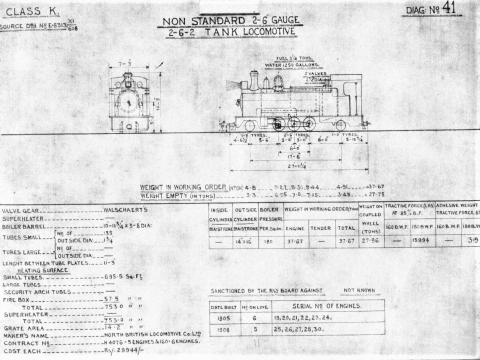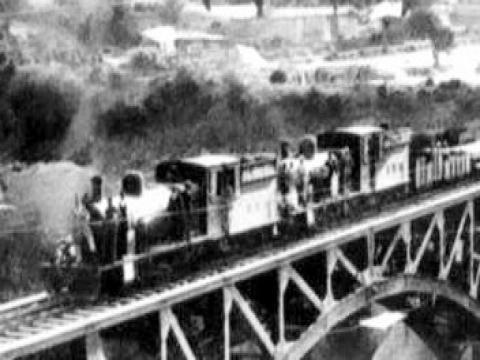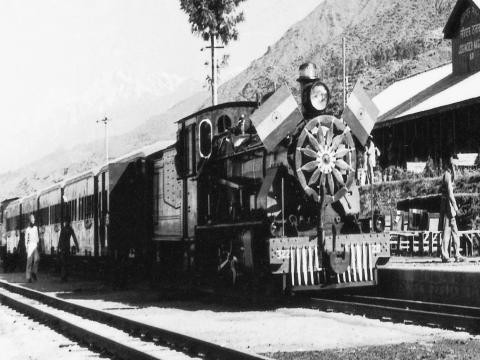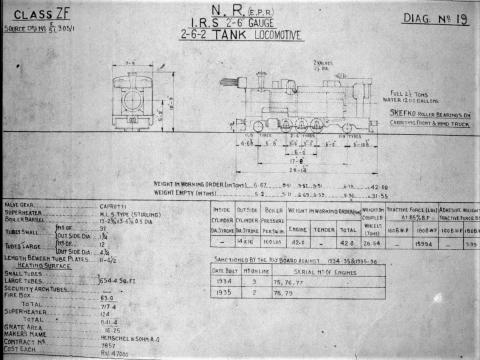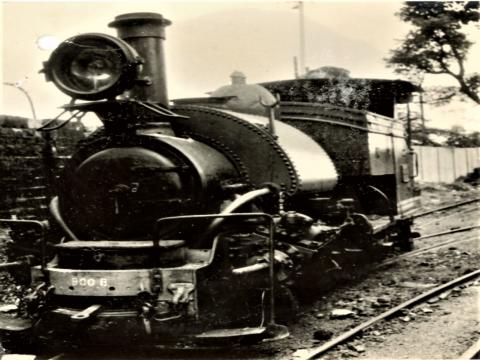The development of Narrow Gauge Locomotive development in India was specific to individual sections and took into account the terrain, gradients and other characteristics of the route. On the Kalka – Shimla line 2’ 6” gauge (1903), for example, initially variants of the well known ‘B’ Class 0-4-0 Tank locomotive of the Darjeeling Himalayan Railway 2’ 0” gauge (1889) were tried out. However, they did not prove to be very successful. Subsequently a 0-4-2 Tank locomotive was introduced. Eventually a much bigger 2-6-2 Tank engine design evolved which was most appropriate and this wheel arrangement became standard for the section.
The early design 2-6-2 Tank Engine of the Kalka - Shimla section came to be known as the ‘K2’ and ‘K’ Class Locomotives and they provided yeoman service on the sharp curves and steep 1 in 33 gradient of this most picturesque Hill Railway of India. These classes of locomotives were manufactured between 1904 and 1910 and some of them were rebuilt later with super-heaters and were reclassified as ‘KC’. One of them KC 520 initially built in 1905 is still in service hauling the occasional tourist train between Shimla and Kanoh more than a century later. There were a range of narrow gauge steam design introduced in different parts of the country.
After the First World War there was a move towards developing an Indian Railway Standard for Narrow Gauge Locomotives. Consequently in 1925 standard designs for six NG classes were finalized viz. ‘ZA’, ‘ZB’, ‘ZC’, ‘ZD’, ‘ZE’ and ‘ZF’. Of these only three classes finally emerged as working locomotives on India’s many isolated narrow gauge sections. These were the ‘ZB’ with a 2-6-2 wheel arrangement and 6 ton axle load, the ‘ZE’ with a 2-8-2 wheel arrangement and 8 ton axle load and the ‘ZF’ which was manufactured in 1934 was very similar to the ‘K’ type of the Kalka – Shimla Line with a 2-6-2 Tank design and an 8 ton axle load, however, with greater grate area, coal and water capacity than the earlier ‘K’ Classes. All three classes were fitted with super-heaters and had a 160 lb boiler pressure. As would be expected the ‘ZF’ class of Locomotive was inducted into service on the Kalka – Shimla line.
Some other designs were also tried out including the ‘Q’ Class a 4-6-2 passenger locomotive built as early 1911, ‘S’ Class with a 2-6-2 engine built in 1921 & 1923 and a ‘TS’ Class articulated locomotive with a 2-6-2 + 2-6-2 wheel arrangement developed in 1927. However they were manufactured in limited numbers.
Details relating to some classes is given in the tables below:
K CLASS: The 2-6-2T ‘K’ Class locomotive was introduced on the Kalka Simla line which proved to be successful and was in use up to the time diesel traction was introduced on the section in 1955. The locomotives which were provided with super heaters the locomotive was classified as ‘KC’.
Valve Gear | Walschaert’s |
Cylinders (Diam X Stroke) in inches | Outside: 14 X 16 |
Super Heater | - |
Boiler Barrel | 10’ 11 3/4” X 3’8” (Diam.) |
Total Heating Surface (Tubes + Fire Box) | 753 Sq. ft. |
Boiler Pressure lb per sq in | 180 |
Tractive Force at 85% Boiler Pressure | 15994 lbs |
Grate Area | 14.2 Sq. ft. |
Maker’s Name | North British Locomotive Co. Ltd. |
Year of Manufacture | 1905 & 1908 |
K2 CLASS:The class is very similar to the ‘K’ class with different boiler barrel dimensions.
Valve Gear | Walschaert’s |
Cylinders (Diam X Stroke) in inches | Outside: 14 X 16 |
Super Heater | - |
Boiler Barrel | 9’ X 4’ (Diam.) |
Total Heating Surface | 750 Sq. ft. |
Boiler Pressure lb per sq in | 180 |
Tractive Force at 85% Boiler Pressure | 15994 lbs |
Grate Area | 14.2 Sq. ft. |
Maker’s Name | North British Locomotive Co. Ltd. |
Year of Manufacture | 1904 |
Q CLASS: This 4-6-2 locomotive was, was designed as a Passenger Locomotive. Prior to 1929 it was known as the ‘N’ Class.
Valve Gear | Walschaert’s |
Cylinders (Diam X Stroke) in inches | Outside :14 ½ X 18 |
Super Heater | - |
Boiler Barrel | 14” X 3’ 9 ½” (Diam.) |
Total Heating Surface | 964 Sq. ft. |
Boiler Pressure lb per sq in | 160 |
Tractive Force at 85% Boiler Pressure | 12253 |
Grate Area | 17.5 Sq. ft. |
Maker’s Name | North British Locomotive Co. Ltd. |
Year of Manufacture | 1911 |
ZB CLASS: A ‘ZB’ Class No 322 manufactured in 1952 by Krauss-Maffei AG, Munchen.
Valve Gear | Walschaert’s |
Cylinders (Diam X Stroke) in inches | Outside :12 X 18 |
Boiler Barrel | ” X ’ ” (Diam.) |
Total Heating Surface | 712 Sq. ft. |
Boiler Pressure lb per sq in | 160 |
Tractive Force at 85% Boiler Pressure | 10368 lbs |
Grate Area | 14 Sq. ft. |
Maker’s Name | Han, Krauss-Maffei AG |
Year of Manufacture | 1928, 1932, 1951, 1952 & 1959 |
ZE CLASS: The 2-8-2 locomotive though designed for freight service was also used on passenger services. The NWR locomotive No 228 shown in the picture was manufactured in 1930 by Hannoversche Maschinenbau AG, Hannover.
Valve Gear | Walschaert’s |
Cylinders (Diam X Stroke) | Outside: 16”X18” |
Super Heater | Stirling MLS Type |
Boiler Barrel | 12’2 ½” X 4’6 9/16” (Diam.) |
Total Heating Surface | 1266 Sq. ft. |
Boiler Pressure lb per sq in | 160 |
Tractive Force at 85% Boiler Pressure | 18432 lbs |
Grate Area | 22.2 Sq. ft. |
Maker’s Name | Nasmyth, Wilson & Co Ltd., Manchester & Hannoversche Maschinenbau AG, Hannover |
Year of Manufacture | 1927 & 1930 |
ZF CLASS: The ZF Class was an improved version of the original ‘K’ &’KC’ class locomotives that had proved their mettle on the hill railways of Northern India. The locomotive No 78 shown in the picture was manufactured in 1935 and has been preserved. The ZF1 was a variant of the ZF with the Walschaert’s valve gear. The ZF1 shown in the picture was manufactured by M/S Krauss-Maffei AG, Munchen as late as 1953
Valve Gear | Caprotti |
Cylinders (Diam X Stroke) | Outside: 14”X16” |
Super Heater | Stirling MLS Type |
Boiler Barrel | 12’2 ½” X 4’6 9/16” (Diam.) |
Total Heating Surface | 841 Sq. ft. |
Boiler Pressure lb per sq in | 180 |
Tractive Force at 85% Boiler Pressure | 15994 |
Grate Area | 16.25 Sq. ft. |
Maker’s Name | Henschel & Sohn, Kassel |
Year of Manufacture | 1934, 1935 |
TS Class : In 1927 M/S Kitson & Co., Leeds in association with Consultants M/S Rendel, Palmer & Tritton developed a design for an articulated locomotive that was suited for the sharp ‘S’ curves of the Kalka – Simla line. These Kitson Meyer Articulated Locomotives had an uncommon innovative wheel arrangement of 2-6-2+2-6-2. Only two locomotives of the type were made for the NWR and they were used on both the Kalka-Simla and Kangra Valley Railway. Both were transferred to Pakistan at the time of partition.
Valve Gear | Caprotti |
Cylinders (Diam X Stroke) | Outside: 13 ½ ” X14” |
Total Heating Surface | 1227 Sq. ft. |
Boiler Pressure lb per sq in | 160 |
Tractive Force at 85% Boiler Pressure | 25025 |
Grate Area | 16.25 Sq. ft. |
Maker’s Name | Kitson & Co., Leeds |
Year of Manufacture | 1927 |
.


